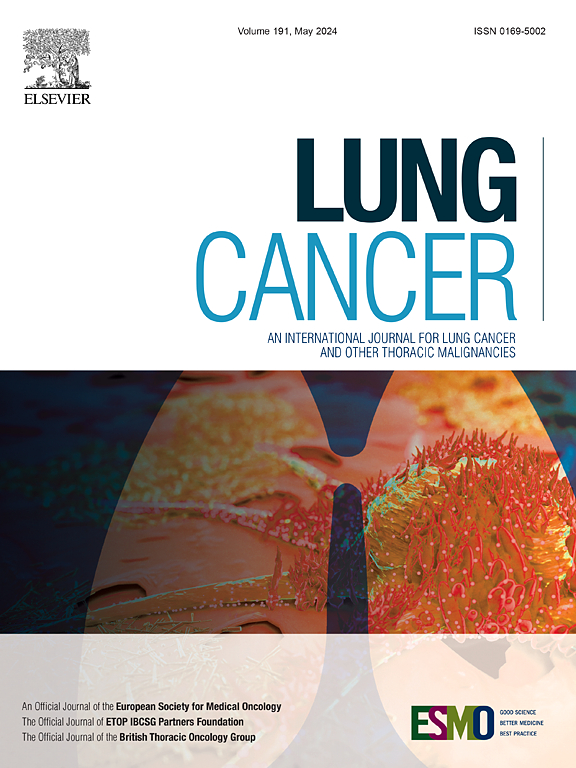超声引导下支气管内低温活检在中心位置肺内病变中的应用:回顾性队列研究
IF 4.4
2区 医学
Q1 ONCOLOGY
引用次数: 0
摘要
背景与目的支气管超声引导下低温活检(EBUS-cryo)能够收集高质量的淋巴结病变标本。将其应用于肺内病变,可为肺肿瘤提供足够的组织质量和数量。因此,我们通过ebus -经支气管针吸(TBNA)形成的通道引入ebus -冷冻,用于中心位置的肺内病变(CLILs),并评估其诊断效用、安全性和CLILs的组织采样能力。方法回顾性分析2023年3月至2024年12月在大阪市立大学医院连续行ebus -低温EBUS-TBNA诊断cll的患者。病理学专家评估所有组织标本的质量和面积,以6分制(1-6)对质量进行评分,其中分数≥5定义为高质量。比较各种活检技术的组织标本质量、面积和诊断性能。结果74例患者中,70例成功纳入分析。EBUS-cryo和EBUS-TBNA的诊断率分别为95.7%和91.4% (P = 0.51)。中度出血5.7%;但未见严重并发症。EBUS-cryo的平均质量评分和标本面积均高于EBUS-TBNA(质量:4.84±1.31比2.27±1.09,P <;0.001;面积:5.90±3.06平方毫米和4.10±3.51平方毫米,P & lt;0.001)。EBUS-cryo的高质量标本回收率高于EBUS-TBNA (177/243, 72.8% vs. 10/227, 4.4%;P & lt;0.001)。结论应用EBUS-cryo技术诊断CLILs具有较高的诊断价值,安全性好,组织取样能力强。本文章由计算机程序翻译,如有差异,请以英文原文为准。
Application of endobronchial ultrasound-guided cryobiopsy for centrally located intrapulmonary lesions: A retrospective cohort study
Background and objective
Endobronchial ultrasound-guided cryobiopsy (EBUS-cryo) enables the collection of high-quality specimens from lymphadenopathy. Expanding its application to intrapulmonary lesions may provide sufficient tissue quality and quantity for lung tumors. Therefore, we introduced EBUS-cryo through the tract created by EBUS-transbronchial needle aspiration (TBNA) for centrally located intrapulmonary lesions (CLILs) and evaluated its diagnostic utility, safety, and tissue sampling capability for CLILs.
Methods
Consecutive patients who underwent EBUS-cryo following EBUS-TBNA to diagnose CLILs at Osaka Metropolitan University Hospital between March 2023 and December 2024 were retrospectively analyzed. An expert pathologist assessed the quality and area of all tissue specimens, grading quality on a six-point scale (1–6), where scores of ≥ 5 defined as high quality. The tissue specimens’ quality, area, and diagnostic performance of each biopsy technique were compared.
Results
Of the 74 cases, 70 successful cases were included in the analysis. The diagnostic yields of EBUS-cryo and EBUS-TBNA were 95.7 % and 91.4 %, respectively (P = 0.51). Moderate bleeding occurred in 5.7 %; however, no severe complications were observed. The mean quality score and specimen area were higher with EBUS-cryo than with EBUS-TBNA (quality: 4.84 ± 1.31 vs. 2.27 ± 1.09, P < 0.001; area: 5.90 ± 3.06 mm2 vs. 4.10 ± 3.51 mm2, P < 0.001). The retrieval rate of high-quality specimens was higher with EBUS-cryo than with EBUS-TBNA (177/243, 72.8 % vs. 10/227, 4.4 %; P < 0.001).
Conclusion
Application of EBUS-cryo to CLILs offers high diagnostic utility, acceptable safety, and superior tissue sampling capability.
求助全文
通过发布文献求助,成功后即可免费获取论文全文。
去求助
来源期刊

Lung Cancer
医学-呼吸系统
CiteScore
9.40
自引率
3.80%
发文量
407
审稿时长
25 days
期刊介绍:
Lung Cancer is an international publication covering the clinical, translational and basic science of malignancies of the lung and chest region.Original research articles, early reports, review articles, editorials and correspondence covering the prevention, epidemiology and etiology, basic biology, pathology, clinical assessment, surgery, chemotherapy, radiotherapy, combined treatment modalities, other treatment modalities and outcomes of lung cancer are welcome.
 求助内容:
求助内容: 应助结果提醒方式:
应助结果提醒方式:


